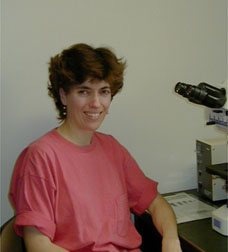
Research interest: Drosophila
cell and developmental biology
The goal of my research is to understand how gametes develop in animals. In many animal species, including insects, frogs, mice and humans, gametes are formed by a similar developmental pathway. After migrating to the site of the developing gonad, each germ cell embarks on a special program of cell division to form a cyst. Germline cysts are clusters of cells that are formed by rounds of mitosis with incomplete cytokinesis; thus, the cells in the cyst remain connected to one another by intercellular bridges. Following cyst formation, the cells enter meiosis, disconnect from one another, and finish developing into mature eggs or sperm. Because the process of cyst formation is highly conserved in evolution, it is likely that cysts play an important role in gamete development.
My lab uses the Drosophila ovary as a model
system for understanding the cellular and molecular mechanisms controlling cyst
formation. We focus in particular on the fusome, an unusual cytoplasmic
organelle found in developing cysts in Drosophila and other insects, which is
composed of a network of endoplasmic reticulum-like tubules, cytoskeletal proteins,
and cell cycle regulatory proteins. Genetic studies have shown that the
fusome plays an essential role in cyst formation and oocyte development; flies
with mutations that disrupt the fusome make aberrant cysts and fail to produce
viable eggs. We are using a variety of approaches - including cell biology,
molecular genetics, and biochemistry - to investigate the structure and function
of the fusome. Current areas of research include: 1) investigating fusome
and cytoskeletal dynamics in living ovaries using timelapse confocal microscopy;
2) developing methods for biochemical purification of fusomes; and 3) using
genetic screens to identify genes required for fusome and cyst development.
We are also taking advantage of the recently completed Drosophila genome sequence
to identify candidate genes of interest. Through these experiments, we
hope to gain insight into the regulation of germ cell division and differentiation
in Drosophila as well as in other organisms, including humans.